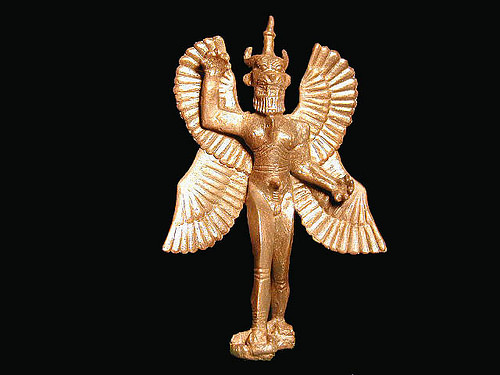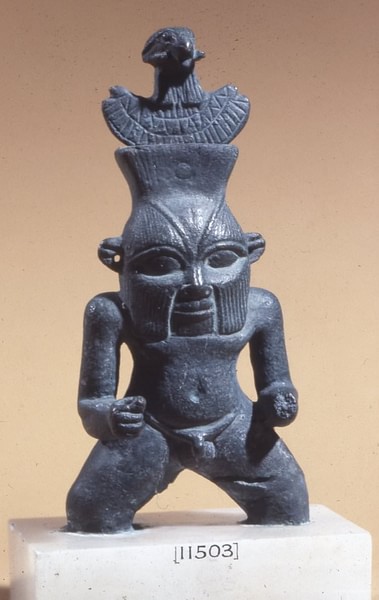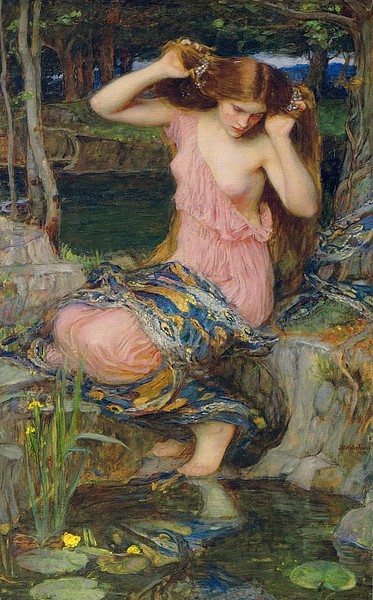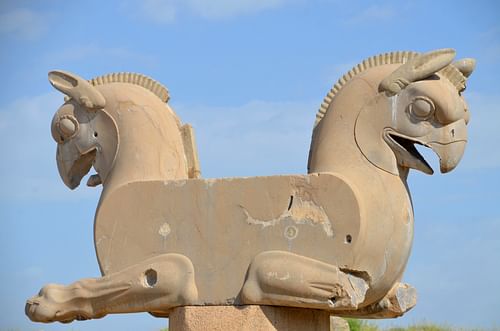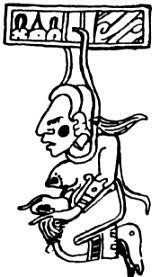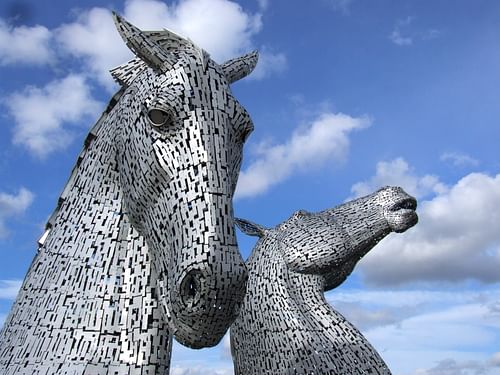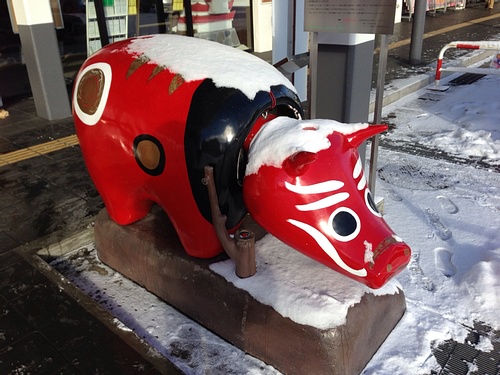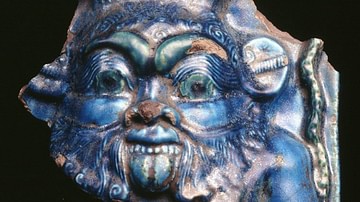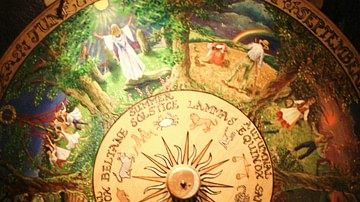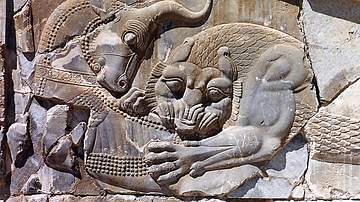The term mythology comes from the Greek words mythos (“story of the people”) and logos (“word”) and so is defined as the spoken (later written) story of a culture. Modern scholars have divided myths into different types which serve many different cultural purposes.
Myths serve to explain the origin of the world, how various aspects of that world operate and why, the meaning of suffering and death and, always, serve to reinforce cultural values. Central to these stories are the supernatural characters – gods, heroes, demons, spirits – whose purpose is to convey the message.
These figures, whatever other purposes they served, were expressions of the fears and hopes of the people. The gods, in every ancient civilization, were considered benevolent in general, but there were always some deities who chose to make life difficult for humanity.
In the same way that one will tend to be more careful to humor and placate an intimidating teacher, professor, or supervisor more than one who is gracious and easy-going, the ancients were careful to make provision for menacing forces before thanking those who only meant them well. Amulets and charms, votive figures, incantations and prayers, gestures and daily devotions were used to protect one's self from supernatural threats and, in some cases, these practices found expression in a specific supernatural being.
Twelve Mythological Figures
The following list comes from cultures around the world, and the figures are chosen as representative of types. There are thousands of such figures from world mythology, and all have their own individual characteristics and particular functions in the culture that gave birth to them.
The twelve entities under consideration are:
- Pazuzu – Mesopotamia
- Bes – Egypt
- Lamia – Greece
- The Lemures – Rome
- Nian – China
- Huma Bird – Persia
- Bhramari – India
- Ixtab – Mesoamerica
- The Morrigan – Ireland
- The Manananggal – Philippines
- The Kelpie - Scotland
- Akabeko – Japan
Some of these are deities but the majority are supernatural entities endowed with powers lesser than the gods but far greater than human abilities. The underlying form of all the creatures signifies change, transformation, which is as inevitable as the human resistance to it. Humans derive comfort from the known and familiar and tend to shrink from, or actively resist, perceived threats to their established norm.
At the same time, there are obvious challenges in life which common sense dictates one should try to avoid such as death, disease, and loss, and these figures represented those threats and the hope of avoiding them. Among the greatest fears of the ancients, judging from the number of artifacts and incantations concerning it, was infant mortality because it threatened not only population growth but social stability.
Pazuzu
Pazuzu, an Assyrian/Babylonian demon from Mesopotamia, arose in response to this threat. He is depicted as a humanoid with a canine face, bulging eyes, scaly skin, large wings, talons, and a snake-headed penis and is best known in the modern day from his central role in the 1970s CE bestselling novel and film The Exorcist. In that work, Pazuzu is the demon who possesses the main character but, originally, he would have been the entity a mother invoked to protect her child.
Pazuzu was undoubtedly an evil and chaotic force, but this was precisely why he was so often called upon for protection. Small images and statuettes of Pazuzu were set up in homes, especially children's rooms, for this very purpose. The image was thought to invoke the spirit himself and, since the human was honoring the demon through that image and homage, Pazuzu would turn his wrath on whatever was threatening the security and safety of the home. He was most frequently invoked against the demon-spirit known as the Lamashtu who preyed on pregnant women and newborn children.
Bes
Bes is the dwarf-god of ancient Egypt who served a similar purpose but was also a fertility deity who presided over human sexuality, humor, and war – all modes of transformation. He was chiefly invoked for the protection of pregnant women and newborns, however, and his image has been found outside the ruins of ancient Egyptian birth houses, homes, and temples dedicated to female deities and fertility, such as the temple of Hathor at Dendera. Bes is depicted as a short man with prominent genitals, bow-legged, bearded, with long, shaggy hair, always grinning. His feminine counterpart was Beset who protected people from ghosts, evil spirits, and malevolent demons, but Bes was most closely associated with the goddess of fertility and childbirth, Taweret (Tauret), usually depicted as a hippopotamus.
Lamia
Greek mythology includes a number of stories concerning the extramarital affairs of the god Zeus and the story of Lamia is among them. Lamia was one of Zeus' mistresses and, when his wife Hera found out, she cursed the woman with insomnia – so she would never have rest – and instilled in her a ravenous hunger for children. Although there does not seem to have originally been any connection between a child's behavior and the threat of Lamia, this came to be her most common characteristic as parents (even as late as the Middle Ages) would use the threat of the Lamia to scare their misbehaving children into obeying them, especially concerning bedtime. Lamia was regarded as an empousa (shape-shifter) by at least the 1st century CE and seen as a seducer of young men whom she would then feast upon like the succubus, with whom she is associated, as well as with the Mesopotamian Lamashtu.
Lemures
The Lemures of Rome were the restless or angry dead who needed to be placated through a festival known as Lemuria (which ran 9, 11, 13 May). This ritual developed from a pair of observances held earlier in the year, Parentalia – which honored the spirits of one's ancestors (13-21 February) – and Feralia – which honored the spirits of loved ones lost (21 February). The dead could return to haunt and trouble the living for any number of reasons but, chiefly, because of improper funeral and burial rites including ignoring their wishes as expressed in wills. The Lemures would disrupt lives, wandering the streets and causing all kinds of trouble (as best described by Ovid in his work Fasti, c. 8 CE), unless Lemuria was observed and they were assured that their grievances would be addressed. The festival of Lemuria is an early precursor to modern-day festivals honoring the dead such as Mexico's Day of the Dead, Halloween, and China's Tomb-Sweeping Day and Ghost Festival.
Nian
The chaos caused by the Lemures was the result of human failings of one sort or another in mortuary rituals but the Nian of China descended on a population simply because that was its nature. The Nian was a giant bird who lived either under the sea or high in the mountains and descended on villages at the pivotal time of the New Year to ravage crops and devour people and livestock. The Nian was larger than any other living being on earth with a lion's face, horned head, and sharp, jutting teeth. It favored men, large animals, and grains but was especially fond of devouring children and destroying villages. There was no chance of killing the bird since it was immortal, but it could be driven off by loud noises and was offended by the color red. It is for this reason that the Chinese New Year is marked by drums, fireworks, firecrackers, parades, and the prominent use of red in decorations.
Huma Bird
The Huma bird of Persia is the exact opposite of the Nian in that, if seen – even only briefly – it brings blessings for life. The Huma is born in flight and never comes to rest on earth, flying eternally in the highest reaches of the sky. Its underlying purpose seems to have initially been to explain fortune since it was thought that, even if one could not see it, if the Huma bird's shadow fell upon a person, they would be blessed. Conversely, if one tried to catch or even kill the bird, one would die soon after and suffer misfortune beforehand.
The flight of the Huma linked it with the highest heavens and so divinity and, in time, it came to be associated with kingship. Images of the Huma can be seen in the ruins of Persepolis and other ancient Persian sites where it resembles the later mythological griffin figure. Its transformative aspect is further epitomized in its association with the phoenix who rises from its own ashes of destruction as the Huma is thought to contain both male and female and give birth to itself in flight.
Bhramari
The Indian goddess Bhramari is an incarnation of the cosmic power known as Shakti. She came into being in response to a crisis which only she could resolve. The demon Aranasura tricked the great god Brahma into giving him a special dispensation whereby Aranasura could not be injured or killed by anything with two or four legs. Once he had this promise, he attacked the homes of the gods and drove them out, throwing the universe into chaos. A great battle between the demons of Aranasura and the gods ensued, but there was no defeating the demon and the gods were driven back until the goddess of fertility and love, Parvati, summoned all the insects of earth to her – bees, flies, mosquitoes, hornets, wasps and all others – and incarnated Shakti-energy as the goddess Brahmari who destroyed the demon army and, with her six-legged insects, was able to kill Aranasura. The gods could then return to their homes and order was restored.
Ixtab
The duality of order vs. chaos is a common theme in mythology and, in Mesoamerica, finds individual expression in the Maya goddess of suicide, Ixtab (pronounced Ish-tahb). Ixtab was envisioned as the rotting corpse of a woman hanging by a noose from the heavens who comforted suicides and brought them safely to paradise after death.
The afterlife of the Maya (and other indigenous Mesoamerican cultures) was a dark and dangerous maze of wrong turns and diabolical schemes intended to keep the soul wandering for as long as possible as it sought the base of the world tree in the underworld which it would then have to climb to reach paradise. Ixtab picked the suicide's soul up before it entered the dark realm of Xibalba and so spared it further misery, thus becoming a stabilizing figure who ensures no death is marginalized. The Maya, as well as other Mesoamerican cultures like the Aztec and Tarascan, also believed in spirit dogs who performed Ixtab's same function for other deaths – such as drowning, a lone death while hunting, children's deaths – in guiding the soul safely through the afterlife.
The Morrigan
The transition from life to death, naturally, has always been seen as the most dramatic – and feared – transformation and, in ancient Ireland, the goddess associated closely with this was the Morrigan, a triple-goddess appearing in a single form who presided chiefly over fate and war. The Morrigan was aligned with the mystical race of the Tuatha de Danaan (Children of Dana) who inhabited the land and were driven underground by the coming of the Formorians and then later races. In the Irish epic Cath Maige Tuired, The Morrigan rallies the Tuatha de Danaan to defeat the Formorians and reclaim their heritage. She also plays a crucial role in the tales of the epic hero Cuchulain, prophesying his death. She was associated with the festival of Samhain (pronounced “soo-when” or “sow-in”), the Celtic New Year, a time when it was thought the veil between the living and the dead was thinnest and the dead could walk among the living and interact with them. The Morrigan could not only predict but influence the future and was also thought to select who would live or die in battle. Her reasons were her own but she always worked for ultimate order through transformation as symbolized by her ability to change shape, notably into a raven, her companion bird.
The Manananggal
The Manananggal of the Philippines is a completely different kind of entity, who thrives on chaos and carnage. A vampire, almost always female, she is depicted as a terrifying being with large wings who walks on earth until she spies her prey and then detaches her torso from her legs to fly quickly and attack. The legs remain in place until she has drained the blood from her victim and torn it apart, after which she reattaches herself and continues on. Her name, in fact, means “to remove” or “separate” which refers to this ability but, figuratively, could be applied to her savage attacks on her prey. Like many such mythological creatures, she is thought to be especially fond of children and, with her long, forked-tongue, sucks the life from a fetus while the pregnant mother is sleeping. Young married couples, grooms-to-be, and brides-to-be are also among its favorite targets but it could be warded off through charms and various spices. The Manananggal epitomized the fear of the dark and the unknown as, like all vampires, it could not endure sunlight which would kill it. If one could find and kill its lower half once it had detached (rubbing salt and/or garlic on it), the Manananggal would die but one risked the upper part returning while one attempted this.
Kelpie
The Kelpie is a shape-shifting water demon from Scotland, usually appearing as a horse but sometimes as a handsome youth, who charms people – most often children and young women – into drawing near or climbing on its back and then pulls them down into the body of water they call home.
The kelpie is among the most popular type of spirit in world mythology – along with the zombie and vampire among others – known as the water sprite or water demon and is the Scottish counterpart to such entities as the Qalupalik of the Inuits, the Shui gui of the Chinese, and the Bunyip of Australia. The primary cultural function of these figures is to scare the most vulnerable members of society – especially children – away from the danger of the water's edge. There are many different versions of the kelpie story but, usually, the entity appears as a beautiful horse emerging from a lake or pond who lures a child – or children – into climbing on its back and then dives into the water, drowning and then eating them, afterwards spitting their intestines up onto the bank. As a shape-shifter, the kelpie can assume any form and so besides warning young people away from potentially dangerous waters, they also encouraged young people to regard strangers with suspicion.
Akabeko
The Akabeko of Japan, on the other hand, is exactly what it appears to be: a cow. According to the legend, there was a cow named Akabeko in the Aizu district of Japan who devoted itself to the workers building a Buddhist temple in the 9th century CE. The cow was thought to have consecrated itself to Buddha and, depending on the version of the legend, either turned itself to stone to become part of the building or simply lived a long and prosperous life on the temple grounds. The cow morphed into a supernatural entity in the 16th century CE when its exemplary life and dedication to the Buddha prompted the lord in power, Toyotomi Hideyoshi (r. 1585-1592 CE), to have his chief artisans make small toys of Akabeko for the region's children. When a smallpox epidemic broke out, the children who had the Akabeko toys were mysteriously spared and the toy was thought to have magical healing and protective qualities derived from the sanctity and holiness of the original Akabeko. These toys are still made in Japan in the present day and are still considered just as potent in protection.
Conclusion
Akabeko's significance typifies that of all mythological creatures in that it was a response to a direct threat to health, security, and safety. In the case of Akabeko, the origin story is well known but, with most mythological entities, it is not. Even so, some event or confluence of circumstance must have given rise to each of the figures presented here and thousands of others the world over. Scholars speculate that the famous Minotaur from Greek mythology, for example, was created by a combination of Athenian fear and suspicion of the Minoans of Crete and the Cretan sport of bull-jumping during which the athlete and the bull seemed to become a single being. The European basilisk is thought to have originated in response to the fear of venomous snakes and how one “froze” upon seeing one, and the kodama, tree-spirits of Japan, to have emerged as an explanation for why trees lived, died, and seemed to 'bleed' sap when cut.
The kodama characterizes the type found in etiological myths – those which explain why things happen as they do or how something came to be. There are also historical myths, psychological myths, national myths, and many other types. Central to most is the theme of transformation and change. Many psychological myths feature a hero on a journey of self-discovery but, even where that archetype is absent, the supernatural creatures who inhabit the tale serve the same purpose in confronting an audience's fears by embodying them and, in many cases, serving to protect against them.
